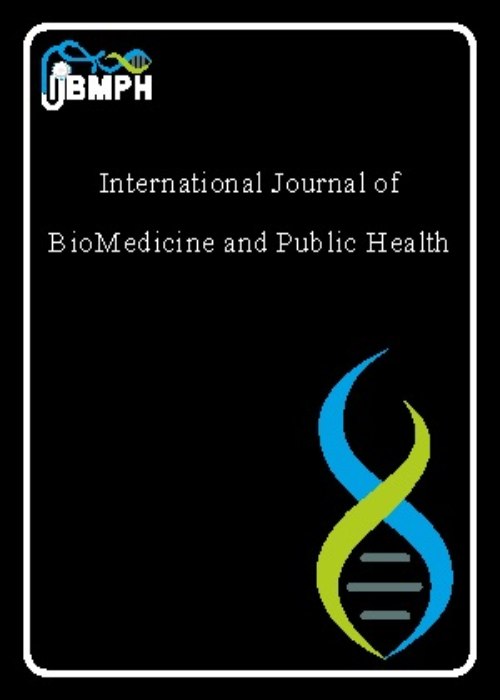فهرست مطالب

International Journal of Biomedicine and Public Health
Volume:3 Issue: 1, Winter 2020
- تاریخ انتشار: 1398/12/11
- تعداد عناوین: 4
-
The effect of cold spray cryotherapy method on the shoulder joint position sense of healthy athletesPages 1-4IntroductionApplication of cryotherapy modalities is common after an acute shoulder injury and as a part of rehabilitation. In sports events, the athlete may return to the game after treatment. The effects of cryotherapy on the shoulder joint position sense (SJPS) have been investigated in many studies. However, the research that used the cold spray for this purpose was not found. This study aimed to evaluate the immediate effect of using a short-term protocol of topical cold spray on shoulder joint position sense in healthy athletes.MethodsThirty physically active academic volleyball players with no history of neurologic conditions or musculoskeletal injuries on the throwing (dominant) shoulder voluntarily participated in this study. A within-subjects design with pre-posttest and selective sampling were conducted in this study. They took part in a reconstruction of the shoulder joint angle test at two sessions; so that their performance accuracy in this reconstruction was evaluated first time without using cold spray and the second time after using cold spray. The paired t-test was employed for SJPS scores comparison. Assessment assumption was done with 95 percent significance and P ≤ 0.05.ResultsDespite a reduction in SJPS accuracy after using a short-term protocol of local cooling, there was no significant difference between the error of the estimated angle before and after cryotherapy (P > 0.05).ConclusionIt appears that the use of a short-term protocol of topical cold spray only has an immediate effect on the more surface receptors, while the deeper receptors such as muscle spindles and joint receptors which have a key role in joint position sense are not affected.Keywords: Position Sense Shoulder Joint, Cryotherapy, Athletes
-
Pages 5-9IntroductionPelvic floor muscle training increases muscle strength and support of pelvic organs. The purpose of this study was to determine the effect of pelvic floor muscles training using biofeedback device on symptoms of urinary incontinence and pelvic organ prolapse in females with anterior and posterior prolapse grades 2 or 3.MethodsIn this interventional study, 20 females with prolapse grades 2 or 3 were examined. Participants were treated with biofeedback 3 sessions/week for 4 weeks. Symptoms of urinary incontinence and prolapses were measured using ICIQ-FLUTS and P-QoL questionnaires, respectively. Prolapse severity was assessed using the POP-Q system and pelvic floor muscle function and strength were evaluated by perineometry.ResultsThe results of this study showed that pelvic floor muscle training significantly increases pelvic floor muscle strength and decreases prolapse severity (P < 0.001 and P < 0.01, respectively). Based on the ICIQ-FLUTS questionnaire, symptoms of filling, voiding, and incontinence improved significantly (P < 0.05, P < 0.01 and P < 0.01, respectively). Our results also showed that the score of quality of life significantly improved based on the ICIQ-FLUTS questionnaire (P < 0.01). The results for P-QOL questionnaire indicated that prolapse symptoms in the areas of general health, prolapse impact, physical limitation, social limitation, personal limitation, emotions, sleep, and severity had a significant difference (P < 0.05) albeit it did not show any significant differences in the role limitation criteria (P > 0.05).ConclusionPelvic floor muscle training using biofeedback improves prolapse symptoms and enhances the quality of life of females with pelvic organ prolapse.Keywords: Pelvic organ prolapse, pelvic floor muscle training, Biofeedback
-
Pages 10-14IntroductionSafety climate is one of the most important indicators for evaluating the performance of safety management and occupational health in the workplace. The aim of this study was to evaluate the influencing indicators of workplace on safety climate and the incidence of accidents in a petrochemical industry.MethodsThis cross-sectional study was conducted in one of the petrochemical industries in Khuzestan Province, Iran in 2017. All operational staff of the petrochemical industry (N=354) were included in the study based on census sampling. Safety climate was evaluated using the Petroleum Safety Authorities (PSA) 2006.ResultsAll participants were male. Work experience was 2-5 years in 27.4% of the participants. No significant relationship was observed between safety climate and accidents in workplace (P > 0.05). There was a significant relationship between disease symptom, physical workplace, psychological factors, safety climate and accidents and occupation group (P < 0.001), education and work experience (P < 0.01). No significant relationship was found between age and safety climate (P > 0.05).ConclusionThe findings of this study showed that “workers’ negative attitude toward management commitment”, “workplace physical factors” and “occupational disease” influenced the incidence of work related accidents. These factors indicate that industrial management commitment to provide a safe climate is necessary to prevent work related accidents and diseases in petrochemical industry.Keywords: Petrochemical industry, Work related accidents, Safety Climate
-
Pages 15-24IntroductionBangladesh is a developing country with a large population. It experienced a significant reduction in under-five child mortality over the past few decades. Nevertheless, the rate of under-five child mortality is still high in Bangladesh. This study aimed to determine the risk factors of under-five child mortality.MethodsIn this study, the dataset from the Bangladesh Demographic Health Survey- 2014 was assessed. We utilized the information on 7760 children that were born in the five years preceding the survey; 314 did not survive, and 7346 were still alive at the time of the survey. The Cox proportional hazard model and the Cox frailty model for testing unobserved heterogeneity among children were used to determining the factors affecting under-five child mortality.ResultsOur results revealed that multiplicity of birth, preceding birth interval, number of antenatal care visits, place of delivery, child-size at birth, total children ever born, and number of living children were the main factors for under-five child mortality. These results also showed that the variance of frailty term was 0.000361.ConclusionOur findings highlight the potential risk factors associated with under-five child mortality in Bangladesh. According to our results, it is evident that special attention should be given to these significant predictors, which may increase the under-five child survival.Keywords: Under-five child mortality, Cox proportional hazard model, Cox frailty model


